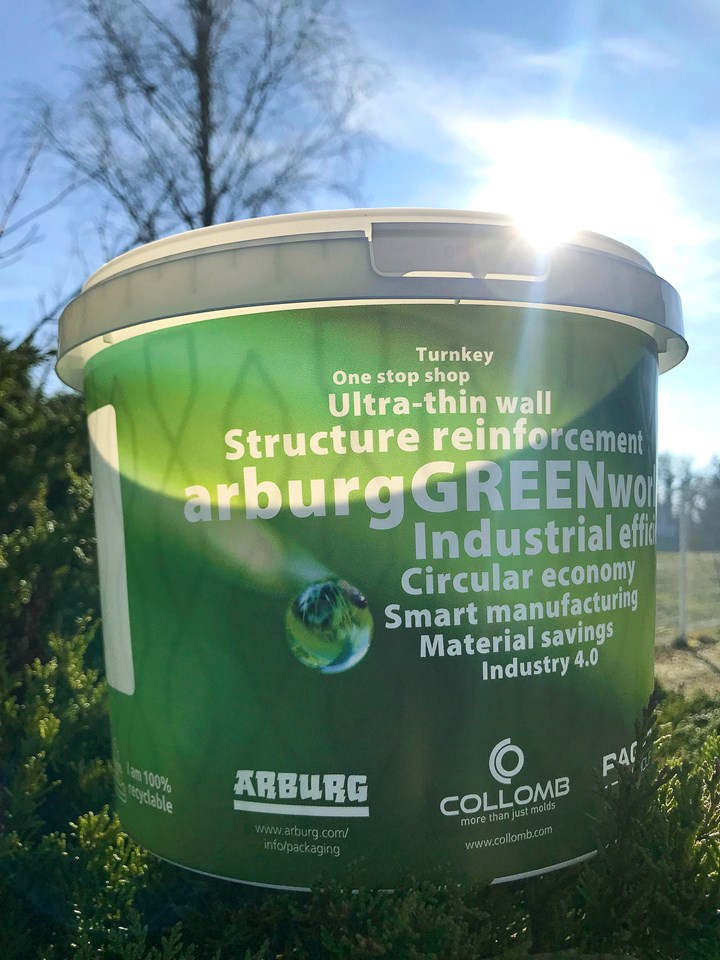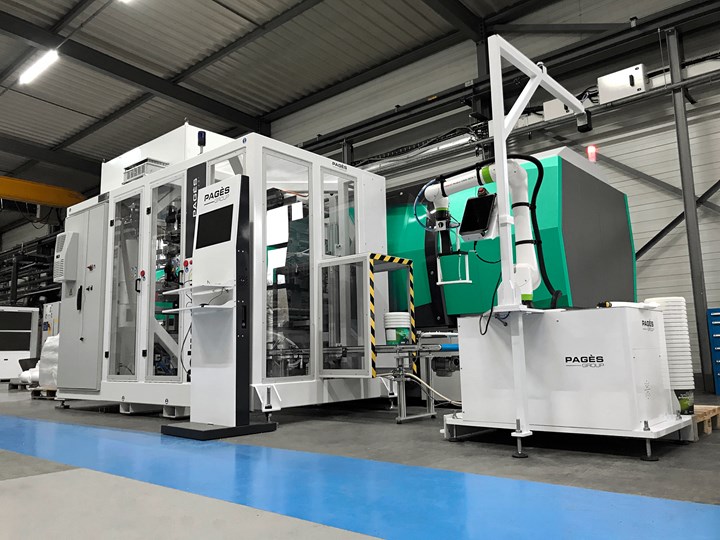Packaging Project Combines Thin Walls, Recycled Content and High Speeds
A collaborative project to produce a 5-liter thin-walled pail brought together Arburg and specialists in mold making, automation, in-mold labeling, material handling and resin supply.
The Thin Wall Integra project combined the technical acumen of Arburg France; Collomb, a French toolmaker focused on thin-walled containers; Pagès Group, a packaging robotics expert; in-mold label (IML) maker Verstraete; material handling equipment supplier Koch-Technik; and the resin maker Borealis.
The result? Fully automated molding of a thin-walled IML-decorated container in a 5-sec cycle from a hybrid Allrounder 720 H running a 1-cavity mold. The finished container is made up of 55% recycled material and thinning the walls to just .63 mm with a new design enables material savings of up to 35%.

The Thin Wall Integra project brought together Arburg and a number of other suppliers to create a thin-wall IML-decorated container from a material featuring predominantly PCR material.
Photo Credit: Arburg
In addition to optimizing the injection molding machine for fastest possible cycle, the robotic system’s movements were streamlined for high speeds. The robot features a telescopic arm that engages from the rear side of the machine to load the mold with the IML labels prior to injection. The robot then removes and stacks the labelled buckets, and those stacks are then automatically picked up by another robot for palletizing. The Verstraete labels utilize ‘HolyGrail 2.0’ labels, which make it easier to identify the resin type post consumer for efficient recycling.
Borealis described to Plastics Technology the material the company provided—UJ599MO-90—as a compounded polyolefin containing 55% post consumer recyclate (PCR). The material has a melt flow rate (MFR) of 70 g/10 min, with the “-90” in its name referencing the material’s white color. As part of the container’s design, there is an integrated geometric pattern. An Arburg spokesperson noted this pattern has a dual goal: increase strength for compression resistance and limit vacuum effect when pails are nested into each other by allowing air flow.
After its premier last November, the Thin Wall Integra project was exhibited during an open house at Collomb in Oyonnax, France in January.

The Thin Wall Integra project brought together Arburg, Collomb, Pages Group, Verstraete, Koch-Technik and Borealis.
Photo Credit: Arburg
Related Content
-
In Sustainable Packaging, the Word is ‘Monomaterial’
In both flexible and rigid packaging, the trend is to replace multimaterial laminates, coextrusions and “composites” with single-material structures, usually based on PE or PP. Nonpackaging applications are following suit.
-
PHA Compound Molded into “World’s First” Biodegradable Bottle Closures
Beyond Plastic and partners have created a certified biodegradable PHA compound that can be injection molded into 38-mm closures in a sub 6-second cycle from a multicavity hot runner tool.
-
Measuring Multilayer Plastic Containers Made Easier With Today's Ultrasonic Gauges
Ultrasonic gauge technology has evolved to simplify measurement of very thin layers in plastic containers. Today’s gauges with high-frequency capabilities and specialized software can make multilayer container measurement quick and easy for ordinary users.















